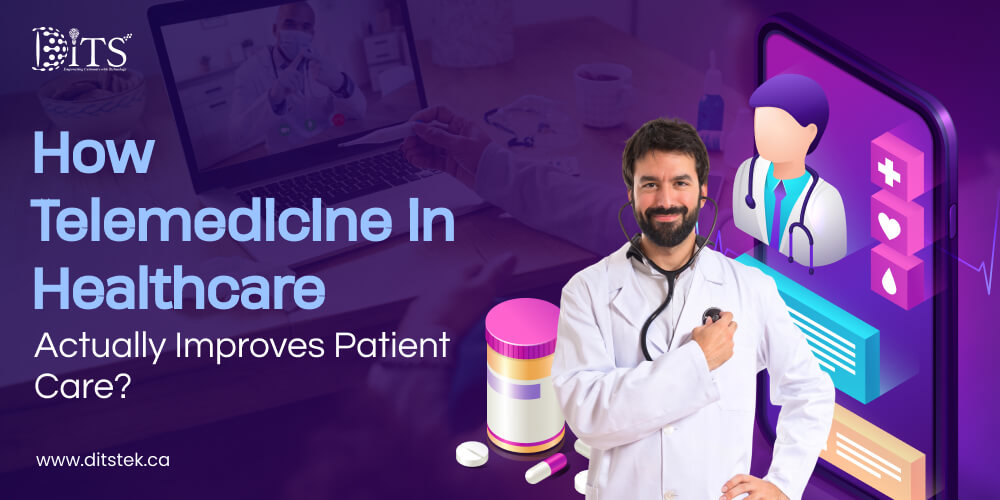How Telemedicine in Healthcare Actually Improves Patient Care
Ditstek Blogs
Improving patient care is the top priority of every business in the healthcare industry. But how exactly does telehealth help achieve this goal?
Over time, the healthcare model has evolved from basic services to value-based care, where quality and results truly matter. This shift has also transformed how providers work toward improving patient experiences.
Being able to schedule a consultation, seek testing, and receive prescriptions all without leaving home or the office is what patients expect today from healthcare providers.
Canada, being one of the largest countries in the world, makes this move even more significant. This blog shares how telemedicine in healthcare is actually improving patient care in Canada.
What is Telehealth and Telemedicine in Healthcare?
Telehealth is the use of communication technologies to provide remote healthcare services to patients. These services can range from online consultations and prescriptions to virtual therapy and monitoring of patient conditions.
Telehealth is another term that is often used interchangeably with telemedicine. However, telehealth is an umbrella term that encompasses educational, administrative, and clinical tools.
On the other hand, telemedicine refers strictly to direct, clinical care delivered via a technology-based service. Both terms enable healthcare systems to look and function differently, but both help improve efficiency and access to patient care.
Impact of Technology on Healthcare
Telehealth and telemedicine are useful for hospitals and clinics that need to integrate patient portals, wearables, and video technology. The ability of medical professionals to share data securely enables them to make quick and accurate decisions for the treatment of patients.
Telehealth Adoption in Canada
The adoption of telemedicine in Canada has been impressive overall. Clinics in smaller settings have partnered with large hospitals to conduct remote consultations to improve patient care and eliminate travel time. This is the next step to make healthcare accessible to everyone, regardless of location or proximity to services.
Ready to Build Your Telemedicine Platform?
Discover how a secure, AI-powered telemedicine solution can enhance patient care and operational efficiency across your healthcare network.
How Does Telemedicine Improve Healthcare and Patient Care
For healthcare providers, telemedicine is more than a technological upgrade. Here are the benefits of telemedicine in healthcare.
Better Accessibility
Telehealth provides patients with immediate access to health services, so they don’t need to wait for appointments. It also facilitates access for patients in rural regions who would otherwise need to travel long distances to access a provider's expertise. Telehealth enables a single facility to serve large populations without expanding its branches.
Improved Coordination
Doctors get instant access to the patient's file, securely share test results, and collaborate with other specialists in real time. Coordination among specialists promotes accurate diagnostics and treatment plans.
Enhanced Patient Experience
Telehealth simplifies scheduling, reduces the need for follow-up visits, and increases overall adherence to health services.
In the Canadian context, all of these benefits translate into better service delivery, more dependable relationships, and a more sustainable healthcare platform for the provider.
Key Ways Telemedicine Improves Patient Care
Now, as we understand telemedicine and its role in healthcare, let us explore some ways in which it helps service providers improve patient care.
Faster Access to Care
By offering virtual visits, physicians can see more patients in a day, achieve better outcomes faster, and manage more appointments. Clinics can see patients more quickly, saving time and allowing doctors to offer a better patient experience.
Better Continuity of Care
Having health records stored digitally enables a smooth coordination of care across departments. Furthermore, the risk of communication fallacies is lower, increasing the quality of care provided to patients.
Enhanced Patient Engagement
Telemedicine/Telehealth Platforms allow healthcare providers to engage with patients by sending appointment reminders, checking the progress, and following up. Accepting communication afterward helps the patient better adhere to their treatment and improves their satisfaction with the service provided.
Improved Chronic Disease Management
Using remote patient monitoring programs, care teams can monitor patients' vitals in real time. Additionally, treatment teams are alerted to act quickly when vitals indicate a problem. This proactive action can help improve patient care and minimize emergency visits.
Convenience and Comfort
When patients can interact with health care providers online, it becomes significantly easier to maintain that relationship. Continuous online connections increase patients' trust and loyalty, even toward the organization in the long run.
Data-Driven Healthcare Decisions
Digital telehealth platforms enable health care organizations to collect vast amounts of valuable data and referrals, helping service providers make more informed decisions. Lastly, this provides additional data to inform the improvement framework when coupled with innovative healthcare software development.
Is Your Clinic Future-Ready for Virtual Care?
Explore how custom-built telemedicine solutions can help your organization scale securely and deliver consistent care experiences.
Impact on Healthcare Providers
As telemedicine helps healthcare providers deliver better patient care and build stronger relationships with their patients, let us know its direct and indirect impact on healthcare businesses.
Greater Operational Efficiency
Telemedicine helps hospitals and clinics reduce administrative work and focus on patient care. With streamlined scheduling and digital documentation, staff spend less time on manual tasks and more time delivering value.
Expanding Reach Across Canada
Healthcare organizations can serve patients across provinces without adding physical infrastructure. A clinic in Toronto can easily consult with patients in remote northern areas, extending its services and growing its client base.
Data and Decision Support
Access to real-time information helps doctors and administrators make faster, more accurate decisions. It also supports predictive planning for staffing, resource allocation, and care delivery.
Building Custom Digital Platforms
Many Canadian healthcare providers are investing in their own telemedicine mobile app for healthcare. By partnering with a custom software development company in Canada, they gain full control over functionality, branding, and integration with existing systems.
At DITS, our development process incorporates AI for software development, quality assurance, and customization. This ensures high performance, strong security, and adaptability for future healthcare needs.
Common Challenges and How to Overcome Them
Despite numerous benefits and improvements in patient care, healthcare providers face challenges when using telemedicine platforms.
Data Security and Compliance
Protecting patient information is essential. Healthcare organizations must adhere to regulatory requirements for privacy policies (e.g., PIPEDA and HIPAA). Platforms that comply with secure access controls and encryption protocols demonstrate that organizations are committed to protecting patient data during transmission.
Training and User Adoption
Improving staff adoption is critical to successful telemedicine implementation. Regular, structured training programs and ongoing support will help medical teams become confident in using new tools and technologies as the healthcare environment continues to evolve.
Integration with Existing Systems
To minimize workflow interruptions, a telemedicine platform must blend into hospital systems' current bedside practices.
Technical and Connectivity Barriers
In rural settings, technology may vary, and unstable internet signals can cause interruptions, affecting consultations. It is important to pick a platform better suited to performance in a slower band.
Choosing the Right Technology Partner
Working with a skilled custom software development company in Canada ensures that every system is built for compliance, security, and scalability.
At DITS, AI tools are embedded throughout the development process, from testing to customization. This makes every telemedicine solution secure, flexible, and ready to scale as technology evolves.
Need a Compliant Telemedicine Platform?
We build telemedicine systems aligned with HIPAA, PIPEDA, and GDPR to keep patient data protected and workflows optimized.
Real-World Examples or Use Cases
Now that we understand the challenges, benefits, and ways telemedicine helps healthcare businesses, let us look at some real-world use cases of telemedicine.
Connecting Remote Areas
Today, many provincial health networks use telemedicine to connect patients in rural or remote communities with urban experts. This leads to quicker diagnoses, less travel, and more satisfied patients.
Managing Chronic Conditions
Hospitals are using remote patient monitoring tools to manage chronic conditions like diabetes and heart disease. Remote monitoring allows clinicians to intervene early and improve patient care.
Post-Surgery Consultations
Many clinics are conducting remote check-ins for post-operative visits, moving care out of the hospital setting to free critical care beds and help reduce costs for both patients and care providers.
Expanding Mental Health Services
In addition to providing more options for people who may not be able to access in-person therapy, virtual therapy and counseling offer healthcare businesses an opportunity to expand their care area and maintain consistent oversight.
Smart Implementation and Growth
Providers that have invested in telemedicine in Canada report higher patient retention and lower cancellation rates. Partnering with a custom software development company in Canada like DITS allows them to tailor systems to their workflows while ensuring compliance and security.
The Future of Telemedicine in Healthcare
Rise of Integrated Systems
Hospitals are moving toward connected systems that combine video consultations, analytics, and automation. With AI-driven software development, these platforms continuously improve and support clinical decision-making.
Hybrid Care as the New Normal
In-person visits will always have a place, but digital consultations are becoming standard. Canadian healthcare organizations offering both options achieve greater flexibility and improved efficiency.
Expanding Access Nationwide
As infrastructure improves, telemedicine in Canada will continue to bring equitable care to all regions, reducing disparities and strengthening the national healthcare network.
At DITS, we specialize in healthcare software development that merges human-centered design with advanced AI automation. Our goal is to help Canadian healthcare providers create connected systems that evolve with technology and patient needs.
How DITS Helps Healthcare Providers Build Secure and Scalable Telemedicine Solutions
DITS develops telemedicine solutions tailored to each healthcare provider’s existing workflows and operational goals. Our software development team guarantees the effective integration of telemedicine solutions with existing hospital systems, minimizing manual labor and maintaining data entry accuracy.
DITS adheres to strict worldwide privacy and security standards, including HIPAA, GDPR, and PIPEDA. Security and privacy protection are embedded into every solution we design, including encryption, secure access, and cloud-based security.
AI powers everything we build; whether testing, optimizing, or personalizing the application for users, we ensure our telemedicine mobile applications for healthcare are all fast, scalable, and future-proof.
As a custom software development company in Canada, DITS has local knowledge and global experience to support healthcare organizations’ growth ambitions in the digital economy.
Want to Partner with a Trusted Canadian Developer?
DITS combines AI, compliance expertise, and healthcare domain knowledge to build scalable telemedicine platforms for tomorrow’s care model.
Conclusion
Telemedicine is an essential part of modern healthcare. It spans distances, increases efficiency, and builds stronger relationships between healthcare teams and their patients.
The real value of telemedicine in healthcare is its ability to significantly improve access to care, optimize resource use, and enhance the quality of care at all levels. Telemedicine is growing so quickly in Canada that healthcare businesses that invest now will be leaders in the future.
At DITS, we help healthcare partners meet the challenges of this change by providing secure, AI-powered telemedicine solutions designed to ensure long-term success. Connected, intelligent, and patient-centered healthcare are the future -- to get there, start by choosing the right technology partner.
FAQ’s
1. What is the purpose of telemedicine in healthcare?
The primary aim of telemedicine in healthcare is to enhance accessibility and/or efficiency of services. Providers can deliver consultations, follow-up care, and monitoring to patients who are unable to access services in person, all while saving patient and staff time and reducing costs.
2. How does telemedicine benefit healthcare organizations in Canada?
For Canadian healthcare providers, telemedicine assists in reaching more patients (including patients residing in very remote areas). It reduces operational costs for clinics while supporting better data collection and management. Clinics can reach patients remotely, use staff time more efficiently, and comply with local telemedicine regulations.
3. Is telemedicine safe for patient data?
Yes. When developed appropriately, telemedicine platforms incorporate secure authentication models and encryption, and restricted user access to safeguard sensitive medical information. At DITS, all solutions provided (i.e., products used, data storage, security protocols, etc.) comply with privacy laws and regulations such as PIPEDA, HIPAA, and GDPR to ensure the full protection of health data.
4. What technologies are commonly used in telemedicine platforms?
Most solutions have a secure video conference platform, digital prescriptions, electronic health records, and Remote patient monitoring devices. These technologies work together to provide a connected and real-time healthcare experience for patients and providers.
5. How Much Does It Cost to Develop a Telemedicine App in Canada?
The overall cost of a telemedicine app in Canada can vary significantly depending on features, complexity, design, and compliance needs. A basic solution starts around CAD 40,000 to CAD 60,000, whereas fully customized platforms with final integrations, video conferencing, and remote patient monitoring can cost CAD 80,000 to CAD 150,000, and sometimes more.
6. What is the ROI for healthcare organizations investing in telemedicine?
The return on investment depends significantly on the size and scope; however, most healthcare providers see reduced costs within the first year, and past missed appointments and the number of direct patients served imply additional revenue.

Nidhi Thakur
With more than 19 years of experience - I represent a team of professionals that specializes in the healthcare and business and workflow automation domains. The team consists of experienced full-stack developers supported by senior system analysts who have developed multiple bespoke applications for Healthcare, Business Automation, Retail, IOT, Ed-tech domains for startups and Enterprise Level clients.
Recent Posts
Get in touch










 Calgary | Edmonton | Vancouver | Toronto
Calgary | Edmonton | Vancouver | Toronto